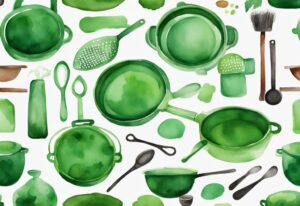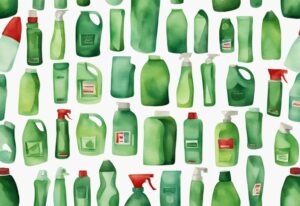Top Picks: Best Non Toxic Acrylic Paint for Creatives in 2021
Did you know there’s a vibrant, healthier choice for you and the earth without compromising your artistic flair? Hello, I’m Olivia Green, the voice behind nontoxicways.com. Today, we’re diving into the world of the best non-toxic acrylic paints.
Navigating the switch to eco-friendly paints, the vibrant colors and lasting quality of non-toxic acrylic paints in 2024, will surprise you! Beyond sustaining your creativity, these paints champion your health and our planet’s welfare — double the reward!
In this guide, I share top picks, buying tips, and how to transition smoothly into using non-toxic acrylic paints. A treasure trove of information awaits you. Keep reading, and let’s journey together towards healthier artistry!
Why Opt for Non-Toxic Acrylic Paints?
These subheadings delve into exploring the profound impacts of choosing non-toxic acrylic paints both on personal health and the environment, illustrating how such choices can lead to a more sustainable and healthier lifestyle.
Artist Health and Non-Toxic Paints
When I first switched to using the best non toxic acrylic paint, it felt like a breath of fresh air—literally. These paints have tremendous advantages for artist health. By reducing exposure to harmful chemicals, they create a safer working environment. Traditional acrylic paints often contain toxic pigments that can pose serious health risks through inhalation of fumes or skin contact. I once had an allergic reaction that served as a painful reminder of these risks. Non-toxic options eliminate such dangers, particularly benefiting artists with chemical sensitivities or those working in confined spaces. Trust me, being able to focus on your creative process without the worry of breathing in hazardous substances or feeling skin irritation is a game-changer.
The Environmental Impact of Using Non-Toxic Paints
Opting for the best non toxic acrylic paint does more than just protect your health—it champions the environment too. Traditional paints are notorious for emitting volatile organic compounds (VOCs) that contribute to air pollution. During one of my eco-research deep dives, I discovered that these emissions exacerbate health problems and deteriorate our planet’s air quality. In contrast, non-toxic paints release significantly fewer VOCs, thus enhancing air quality.
Furthermore, environmentally-friendly formulations of non-toxic paints are crafted to be less harmful when disposed of, which means they have a minimal impact on water supplies. This aligns so well with sustainable art practices, as these paints are free from heavy metals and other harmful additives. The switch to non-toxic acrylic paints not only serves personal well-being but also aligns with eco-friendly values, promoting a healthier planet for us all.
By making thoughtful choices about the products we use, like choosing the best non toxic acrylic paint, we can protect our health and contribute positively to the environment. For more insights on the importance of using safe art supplies, check out this resource on toxic art supplies: https://greenamerica.org/green-living/toxic-art-supplies. It’s a win-win scenario, and every small step counts.
Identifying the Best Non-Toxic Acrylic Paints
What to Look for: Pigmentation, Finish, Blending Capabilities
Choosing the best non-toxic acrylic paint starts with understanding high-quality pigmentation. Pigmentation affects color vibrancy and longevity, ensuring your artwork remains lively over time. Look for paints that offer strong pigmentation to avoid dull results.
Consider the variety of finishes available. Acrylic paints come in finishes such as matte, satin, and glossy. A matte finish offers a smooth, non-reflective surface, ideal for a modern aesthetic. Glossy finishes provide a shiny look for vibrant pieces, while satin finishes offer balanced sheen, perfect for various styles.
Blending capabilities are crucial for smooth transitions and detailed work. Non-toxic acrylic paints with good blending properties allow seamless color mixing on your palette or the painting surface. This capability is vital for creating nuanced and layered artwork, whether you’re a beginner or an experienced artist.
Understanding Durability and Lightfastness
Durability is fundamental, especially for artworks meant to last years. Opt for non-toxic acrylic paints known for their resilience against fading and wear. Durable paints maintain their integrity, providing long-lasting satisfaction.
Lightfastness indicates how well the paint withstands light exposure without discoloring. High lightfastness ensures your art’s colors remain vibrant even in well-lit environments. Selecting paints with excellent lightfastness is essential for creating enduring works.
Interpreting ASTM D-4236 Standards and AP Certified Seals
Understanding safety certifications and standards is crucial when identifying the best non-toxic acrylic paint. The ASTM D-4236 standard evaluates and labels art materials for safety, confirming no health risks during use. This certification provides peace of mind, assuring rigorous safety testing.
Another vital certification is the AP (Approved Product) seal from the ACMI (Art and Creative Materials Institute). This seal guarantees the products are non-toxic and safe, meeting stringent safety requirements. Look for these certifications on paint labels. These markers not only verify safety but also compliance with established standards, ensuring reliability and safety for extended use.

Potentially Harmful Ingredients in Regular Acrylic Paints
The Dangers of Heavy Metals and VOCs
Regular acrylic paints can be a hidden hazard, often loaded with harmful heavy metals and volatile organic compounds (VOCs).
Heavy metals like cadmium, cobalt, and lead are frequently used to create vibrant hues but come with serious health risks. Cadmium, for instance, is notorious for its bright yellow pigment, yet it is a known carcinogen. Lead, often utilized for its rich colors, can cause cognitive impairments and other severe health issues.
Imagine painting your masterpiece, unaware that these toxic substances could lead to neurological damage and respiratory problems. The vibrant colors we love often mask the dangerous reality lurking within these paints.
Then there are VOCs, such as formaldehyde and benzene, which are common in many regular acrylic paints. These compounds act as solvents and additives to enhance performance, but they release hazardous fumes during application and drying. Breathing in these fumes can trigger headaches and dizziness, and prolonged exposure can damage the liver and kidneys.
Choosing the best non toxic acrylic paint is an effective way to avoid these risks. Non-toxic alternatives are specially formulated to exclude these dangerous substances. They significantly reduce harmful fume emissions and eliminate the threat posed by heavy metals.
By opting for non-toxic acrylic paints, you create a safer environment for yourself and those around you. This choice not only protects your health but also ensures the vibrant quality of your artwork remains uncompromised. It’s a step toward a more sustainable and healthy artistic practice, making it possible to enjoy painting without the worry of hidden dangers.
Top Brands for Non-Toxic Acrylic Paint
Looking for the best non-toxic acrylic paint? Here are some standout brands that prioritize safety without compromising on quality.
The Best Offerings from Arteza, Crafts 4 ALL, and Winsor & Newton
Arteza has always been my go-to for premium-grade, non-toxic acrylic paints. Their paints are ACMI certified, which means they meet stringent safety standards, giving you peace of mind as you create. The rich pigmentation and smooth consistency are a delight to work with. Whether you’re a novice or a seasoned pro, Arteza offers a wide range of vibrant colors that blend effortlessly, making it perfect for detailed work and smooth transitions. Arteza’s dedication to non-toxic formulations ensures a safer creative environment, allowing you to focus solely on your art without health concerns.
Crafts 4 ALL offers an impressive lineup of non-toxic acrylic paints with bright and lively hues. These paints are versatile and perform exceptionally well on a variety of surfaces including canvas, wood, and fabric. Ideal for beginners and professionals alike, Crafts 4 ALL paints can be easily cleaned with soap and water, simplifying your painting process. Their affordable pricing makes high-quality non-toxic acrylic paints accessible to everyone. With vibrant colors and a safe formulation, Crafts 4 ALL ensures you can create stunning artwork while keeping your health in check.
Winsor & Newton is a name that has long been synonymous with quality in the art supplies industry. Their non-toxic acrylic paints stand out for their excellent lightfastness and permanence, meaning your artworks will look as vibrant as the day you finished them, for years to come. For those interested in skincare, you might also want to check out our Skinceuticals Triple Lipid restore reviews for top-rated products. The smooth finish and consistent coverage provided by Winsor & Newton paints make it easier to achieve the desired effects in your work. Their commitment to non-toxic ingredients means you can create in a safer, healthier environment. This balance of safety and high standards is why so many artists choose Winsor & Newton for their creative projects.
By opting for non-toxic acrylic paints from Arteza, Crafts 4 ALL, and Winsor & Newton, you gain the dual benefits of exceptional performance and enhanced safety. These brands are dedicated to innovation and quality, ensuring that your artistic journey is both creative and safe.
How to Choose the Right Non-Toxic Acrylic Paint for You
Taking into Account Surfaces, Techniques, Skill Level, and Budget
Choosing the best non toxic acrylic paint requires attention to several key factors. One crucial factor is the surface you plan to paint on. Whether it’s canvas, wood, fabric, or another medium, selecting the appropriate paint type ensures optimal adhesion and finish.
For instance, some non-toxic acrylic paints are specifically formulated for fabric and offer better permanence and flexibility for textile projects, while others might be more suitable for canvas or wood.
Your artistic techniques also play a significant role in your choice. If your style involves fine detailing, you’ll need paints that provide smooth coverage and sharp lines. Non-toxic acrylic paints with a creamy consistency can facilitate intricate works by allowing more control over brush strokes.

On the other hand, artists who prefer impasto techniques, which require thick paint applications, would benefit from paints with higher viscosity to maintain texture and depth.
Another consideration is your skill level. Beginners might find it easier to work with student-grade non-toxic acrylic paints that are more forgiving and economical, providing a great introduction to painting without significant investment. As you advance, you may opt for professional-grade non-toxic paints that offer superior pigmentation and blending capabilities, enhancing the quality and vibrancy of your artwork.
Budget is also an essential aspect. While the best non toxic acrylic paint options are generally competitively priced compared to traditional paints, prices can still vary significantly.
It’s wise to compare different brands and consider buying in bulk or kits to save costs. Some prestigious brands might have higher prices due to their advanced formulations and reputable certifications, but they can be worthwhile investments for serious artists.
Incorporating these considerations will not only help you in selecting the best non toxic acrylic paint but also enhance your overall painting experience, ensuring both health and artistic satisfaction.
Guidelines for Using and Caring for Non-Toxic Acrylic Paints
The Importance of Ventilation Even with Non-Toxic Paint
Ensuring proper ventilation is crucial when using the best non toxic acrylic paint to minimize any potential exposure to fumes. Even though non-toxic paints are safer, they can still emit mild odors, especially during the drying process. Working in well-ventilated areas or utilizing exhaust systems will further enhance air quality and provide added safety.
This approach not only protects your health but also ensures a more pleasant painting experience by reducing any lingering odors associated with acrylic paint drying.
Safe Paint Cleaning and Disposal Methods
Proper cleaning and disposal techniques are essential for maintaining the quality of your painting tools and minimizing environmental impact when using the best non toxic acrylic paint. Clean brushes and tools thoroughly with soap and water instead of harsh solvents, which can be harmful to both your health and the environment.
Dispose of paint residues and containers responsibly by following local regulations for hazardous waste, thus preventing pollution of water supplies. Additionally, avoid rinsing large quantities of paint into drains to prevent contamination of your water supply and ensure that even safe products are used in an environmentally conscious way.
Implementing these practices helps foster sustainable art habits and supports a healthier ecosystem.
FAQ: Answers to Vital Questions about Non-Toxic Acrylic Paints
Non-Toxic vs Regular Acrylic Paints: What’s the Difference?
Non-toxic paints eliminate harmful chemicals and heavy metals, safeguarding both health and the environment. Regular acrylic paints, on the other hand, frequently contain volatile organic compounds (VOCs) and toxic pigments, posing potential health risks through inhalation or skin contact.
When I first switched to non-toxic acrylic paints, I noticed an immediate difference in the air quality of my small studio. It’s a relief knowing my creative space is now a safer, healthier environment. Plus, it’s comforting to think I’m contributing positively to both my well-being and the planet’s by making this choice.
Are Non-Toxic Acrylic Paints More Costly?
Non-toxic acrylic paints are generally competitively priced with traditional options, making them accessible for many artists. However, some specialty non-toxic paints may be priced higher due to their advanced and safer formulations. The difference in cost is typically minimal and worth it for the peace of mind.
In my experience, the slightly higher price for some brands is an investment in quality and health. It’s reassuring to use products that align with a lifestyle striving for non-toxicity. Plus, these paints often go a long way, making the small additional cost feel minuscule over time.

Do Non-Toxic Paints Perform as Well as Toxin-Loaded Counterparts?
Yes, high-quality non-toxic paints offer comparable performance in terms of pigmentation, blending capabilities, and durability. Thanks to innovations in formulation, the performance gap between non-toxic and toxin-loaded acrylic paints has significantly narrowed.
Personally, I’ve found that non-toxic paints provide the vibrant colors and smooth application I need for my projects. The initial concerns I had about compromising on quality were unfounded. Today’s non-toxic options stand toe-to-toe with traditional paints, allowing for beautiful, seamless artistry without the harmful side effects.
What Are the Leading Non-Toxic Acrylic Paint Brands?
Top brands for the best non toxic acrylic paint include Arteza, Crafts 4 ALL, and Winsor & Newton. These brands are renowned for their high-quality, vibrant, and safe acrylic paints, which are certified by recognized safety standards.
My favorites? Arteza’s color richness is perfect for my detailed work, while Crafts 4 ALL offers an impressive range of hues for diverse projects. Winsor & Newton never fail with their impeccable consistency. When considering other products, it’s important to ask, is herbal essence good for enhancing your creative process? Whether you’re a professional artist or a hobbyist, these brands ensure you don’t have to sacrifice health for excellence.
Conclusion: Embrace Non-Toxic Acrylic Paints for a Safer Artistic Experience
Switching to non-toxic acrylic paints is a transformative step for both personal health and environmental care. For artists, the workspace becomes a sanctuary free from harmful fumes and toxic chemicals. Without worrying about inhaling dangerous compounds or skin contact with hazardous ingredients, artists can focus entirely on their craft, fostering creativity in a safer environment.
Moreover, non-toxic acrylic paints contribute significantly to ecological sustainability. Unlike traditional paints, these alternatives emit fewer volatile organic compounds (VOCs), minimizing air pollution. By choosing paints that lack heavy metals and poisonous additives, artists play a crucial role in safeguarding water systems from contamination. Environmentally-friendly formulations ensure that disposing of paint waste is less harmful, aligning artistic practices with profound environmental responsibility.
Performance-wise, the best non-toxic acrylic paints do not lag behind their conventional counterparts. They offer vibrant pigmentation, varied finishes, and excellent blending capabilities, making them versatile for different artistic techniques. Ongoing advancements in paint technology mean that non-toxic options deliver durability and lightfastness equivalent to traditional acrylics, ensuring the longevity of your artwork.
By opting for certified non-toxic acrylic paints from reputable brands, like Arteza, Crafts 4 ALL, and Winsor & Newton, artists are assured of quality and safety. These brands are recognized for adhering to strict standards, ensuring that their products are safe without sacrificing the artistic results.
Embracing non-toxic acrylic paints is not just a move towards better health and a greener environment; it represents a merge of ethical choices with high-quality artistic output. Transitioning to these paints means engaging in mindful creativity, providing peace of mind without compromising the integrity or vibrancy of art.
Hi, I’m Olivia Green, the voice behind nontoxicways.com. I’m passionate about helping you make the shift to a healthier, non-toxic lifestyle without feeling overwhelmed. I love sharing my personal journey, from small changes to big transformations, along with practical tips that make it all feel doable. My goal is to inspire and guide you toward a lifestyle that benefits both your well-being and the planet. Let’s take this journey together, one simple step at a time!














Post Comment